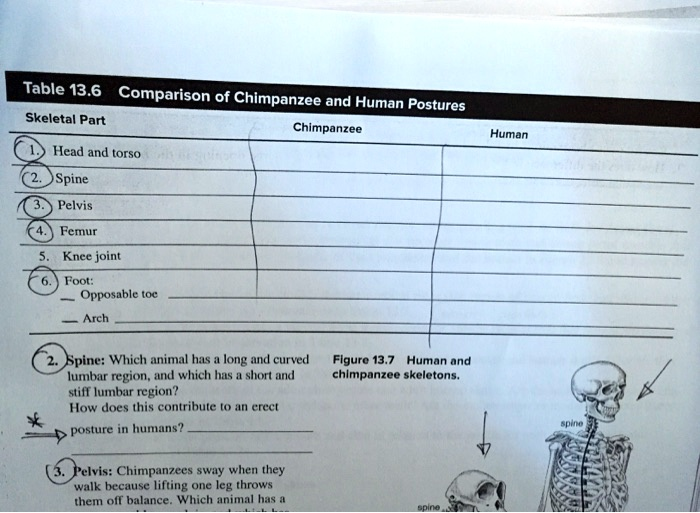Comparison of Chimpanzee and Human Postures Skeletal Part 1.) Head and torso 2. Spine 3. Pelvis 4. Femur Chimpanzee 5. Knee joint 6. Foot: Opposable toe Arch 2. Spine: Which animal has a long and curved lumbar region, and which has a short and stiff lumbar region? How does this contribute to an erect posture in humans? 3. Pelvis: Chimpanzees sway when they walk because lifting one leg throws them off balance. Which animal has a Figure 13.7 Human and chimpanzee skeletons. spine Human spine

The Correct Answer and Explanation is:
Answer:
- Spine: Humans have a long and curved lumbar region, while chimpanzees have a short and stiff lumbar region.
- Pelvis: Humans have a more stable pelvis structure that aids in maintaining balance during bipedal locomotion.
Explanation
The structural differences in the spine and pelvis between chimpanzees and humans are critical to understanding how humans maintain an upright, bipedal posture. The human spine features a pronounced S-shaped curve, especially in the lumbar region. This curvature acts like a spring, absorbing shock and distributing the weight of the upper body evenly across the pelvis and lower limbs. The long and curved lumbar region in humans allows the torso to balance directly over the hips, which is essential for standing and walking upright. In contrast, chimpanzees possess a short and stiff lumbar spine, which limits their ability to align their torso vertically. As a result, they typically walk on all fours and only occasionally adopt a bipedal stance.
The pelvis also plays a crucial role in bipedal locomotion. In humans, the pelvis is shorter and broader, with a bowl-like shape that supports internal organs and provides a stable base for the attachment of muscles involved in walking. This configuration allows humans to lift one leg while maintaining balance on the other, enabling smooth and efficient bipedal movement. Chimpanzees, however, have a longer and narrower pelvis. When they attempt to walk upright, the shape of their pelvis causes them to sway from side to side, making their gait less stable and more energy-consuming.
Together, the long curved lumbar spine and the broad, stable pelvis in humans are evolutionary adaptations that support an erect posture and efficient bipedal locomotion. These features distinguish human skeletal structure from that of chimpanzees and are fundamental to our ability to walk upright over long distances.
